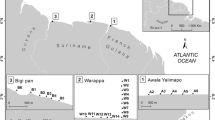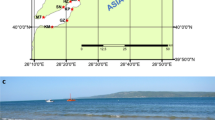Abstract
The increasing impact of human activities, global warming, rising sea levels, and alien species invasion are major drivers of ecological changes in the benthic ecosystems of the Wadden Sea. Repeated benthological and sedimentological investigations have been conducted for intertidal flats, offshore regions, and estuaries. There is a gap in knowledge, however, with respect to the spatial distribution and structure of benthic communities in tidal channel systems of the Wadden Sea. In this study, the spatial distribution of subtidal macrofauna communities in relation to environmental variables in the lesser-known tidal channels of Jade Bay (Wadden Sea of Lower Saxony, southern North Sea) were investigated. In 2009, grab samples were taken at 29 stations, and a total of 98 macrofauna taxa were recorded, with polychaetes predominating. Distinct macrofauna communities among and within the tidal channels were identified using multivariate statistics. Distance-based linear models revealed that tidal current velocity and depth best explained the spatial variation in macrofauna community structure. On a smaller spatial scale, within the tidal channels, the relationships between macrofauna communities and sediment characteristics were greater. Oligochaete species (Tubificoides benedii, Tubificoides pseudogaster, Heterochaeta costata), Peringia ulvae, and polychaetes (Hediste diversicolor, Nephtys hombergii, Streblospio benedicti) showed the highest correlation with the multivariate abiotic data. In addition, species such as the anemone Urticina felina were found to benefit from the presence of hard substrates (patches of gravel), which highlights the importance of local habitat heterogeneity. A comparison among different subtidal basins in the Wadden Sea based on dominant macrofauna species revealed that the macrofauna community structure of Jade Bay showed the greatest similarity with communities of the western Dutch Wadden Sea. In contrast, the greatest dissimilarity was found between the Jade Bay and Sylt communities, likely attributable to differences in sedimentological and hydrodynamical characteristics.







Similar content being viewed by others
References
Anderson MJ (2001) Permutation tests for univariate or multivariate analysis of variance and regression. Can J Fish Aquat Sci 58:626–639
Anderson MJ (2006) Distance-based tests for homogeneity of multivariate dispersion. Biometrics 62:245–253
Anderson MJ, Walsh DCI (2013) PERMANOVA, ANOSIM, and the Mantel test in the face of heterogenous dispersions: what null hypothesis are you testing? Ecol Monogr 83:557–574
Anderson MJ, Ford RB, Feary DA, Honeywill C (2004) Quantitative measures of sedimentation in an estuarine system and its relationship with intertidal soft-sediment infauna. Mar Ecol Prog Ser 272:33–48
Anderson MJ, Gorley RN, Clarke KR (2008) PERMANOVA+ for PRIMER: guide to software and statistical models. PRIMER-E Ltd., Plymouth
Arens S, Götting E (1987) Das Vareler Fahrwasser im Jadebusen: Bodenrelief, Sedimente und Makrozoobenthos. Studienbegleitender Leistungsnachweise im Fach Zoologie, University of Oldenburg, pp 78
Armonies W, Reise L (2003) Empty habitats in coastal sediments for populations of macrozoobenthos. Helgol Mar Res 56:279–287
Babu CP, Brumsack H-J, Schnetger B (1999) Distribution of organic carbon in surface sediments along the eastern Arabian sea: a revisit. Mar Geol 162:91–103
Beck M, Böning P, Schückel U, Stiehl T, Schnetger B, Rullkötter J, Brumsack HJ (2013) Consistent assessment of trace metal contamination in surface sediments and suspended particulate matter: a case study from the Jade Bay, NW Germany. Mar Pollut Bull 70:100–111
Behre KH (2004) Coastal development sea-level change and settlement history during the later Holocene in the Clay District of Lower Saxony (Niedersachsen) northern Germany. Quat Int 112:37–53
Blanchet H, de Montaudouin X, Chardy P, Bachelet G (2005) Structuring factors and recent changes in subtidal macrozoobenthic communities of a coastal lagoon, Arcachon Bay (France). Estuar Coast Shelf Sci 64:561–576
Buhs E, Reise K (1997) Epibenthic fauna dredged from tidal channels in the Wadden Sea of Schleswig-Holstein: spatial patterns and long-term decline. Helgoländer Meeresun 51:343–359
Burchard H, Bolding K (2002) GETM—a general estuarine transport model. Sci Doc EUR 20253 EN. Inst for Environ and Sustainability, Ispra
Common Wadden Sea Secretariat, World Heritage Nomination Project Group (2008) Nomination of the Dutch-German Wadden Sea as World Heritage Site. Wadden Sea Ecosystem No. 24. Common Wadden Sea Secretariat, Wilhelmshaven
Compton TJ, Holthuijsen S, Koolhaas A, Dekinga A, ten Horn J, Smith J et al (2013) Distinctly variable mudscapes: distribution gradients of intertidal macrofauna across the Dutch Wadden Sea. J Sea Res 82:103–116
Dauvin JC, Thiébaut E, Gomez-Gesteira JL, Gherttsos K, Gentil F, Ropert M, Sylvand B (2004) Spatial structure of a subtidal macrobenthic community in the Bay of Veys (western Bay of Seine, English Channel). J Exp Mar Biol Ecol 307:217–235
Degraer S, Moulaert I, van Hoey G, Vincx M (2007) Sieving alive or after fixation: effects of sieving procedure on macrobenthic diversity, density and community structure. Helgol Mar Res 61:143–152
Dekker R (1989) The macrozoobenthos of the subtidal western Dutch Wadden Sea. I. Biomass and species richness. Neth J Sea Res 23:57–68
Dittmann S (1999) The Wadden Sea ecosystem - Stability properties and mechanisms. Springer, Berlin
Dörjes J (1981) Zur Besiedlung von Prielgleithängen. Senckenb Marit 13:43–55
Dörjes J (1992) Langzeitentwicklung makrobenthischer Tierarten im Jadebusen (Nordsee) während der Jahre 1974 bis 1987. Senckenb Marit 22:37–57
Dörjes J, Gadow S, Reineck HE (1969) Die Rinnen der Jade (südliche Nordsee). Sediment und Makrobenthos. Senckenb Marit 50:5–62
Enemark J (2005) The Wadden Sea protection and management scheme – towards an integrated coastal management approach? Ocean Coast Manag 48:996–1015
Folmer EO, Drent J, Troost K, Büttger H, Dankers N, Jansen J, van Straten M, Millat G, Herlyn M, Philippart CMJ (2014) Large-scale spatial dynamics of intertidal mussel (Mytilus edulis L.) bed coverage in the German and Dutch Wadden Sea. Ecosystems. doi:10.1007/s10021-013-9742-4
Götschenberg A, Kahlfeld A (2008) The Jade. Kueste 74:263–274
Hartmann-Schröder G (1996) Annelida, Borstenwürmer, Polychaeta. Tierwelt Deutschlands. Teil 58. Gustav Fischer, Jena
Haubois A-G, Guarini J-M, Richard P, Blanchard GF, Sauriau P-G (2002) Spatio-temporal differentiation in the population structure of Hydrobia ulvae on an intertidal mudflat (Marennes-Oléron Bay France). J Exp Mar Biol Ecol 371:1–12
Helguera Y, Díaz-Asencio L, Fernández-Garcés R, Gómez-Batista M, Guillén A, Díaz-Asencio M, Armenteros M (2011) Distribution patterns of macrofaunal polychaete assemblages in a polluted semi-enclosed bay: Cienfuegos, Carribean Sea. Mar Biol 7:757–768
Kabat P, Bazelmans J, van Dijk J, Herman PMJ, van Oijen T, Pejrup M, Reise K, Speelman H, Wolff WJ (2012) The Wadden Sea Region: towards a science for sustainable development. Ocean Coast Manag 68:4–17
Legendre P, Anderon MJ (1999) Distance-based redundancy analysis: testing multispecies responses in multifactorial ecological experiments. Ecol Monogr 69:1–24
Legendre P, Birks HJB (2012) Chapter 8: from classical to canonical ordination. In: Birks HJB, Lotter AF, Juggins S, Smol JP (eds) Tracking environmental change using Lake sediments, vol 5: data handling and numerical techniques. Springer, Dordrecht, pp 201–248
Legendre P, Gallagher ED (2001) Ecologically meaningful transformations for ordination of species data. Oecologia 129:271–280
Legendre P, Trush SF, Cummings VJ, Dayton PK et al (1997) Spatial structure of bivalves in a sandflat: scale and generating processes. J Exp Mar Biol Ecol 216:99–128
Linke O (1939) Die Biota des Jadebusenwattes. Helgoländer Meeresun 1:201–348
McArdle BH, Anderson MJ (2001) Fitting multivariate models to community data: a comment on distance-based redundancy analysis. Ecology 82:290–297
Molan AL (1999) Size and performance of Juvenile marine Invertebrates: potential contrasts between intertidal and subtidal benthic habitats. Am Zool 39:304–312
Nehmer P, Kröncke I (2003) Macrofaunal Communities in the Wichter Ee, a channel system in the East Frisian Wadden Sea. Senckenb Marit 32:1–10
Nicastro A, Bishop MJ (2013) Weak and habitat-dependent effects of nutrient pollution on macrofaunal communities of southeast Australians estuaries. PLoS ONE 8:e65706-1–e65706-10
Olsson J, Bergström L, Gardmark A (2013) Top-down regulation, climate and multi-decadal changes in coastal zoobenthos communities in two Baltic Sea areas. PLoS ONE 8:e64767-1–e64767-13
Pearson TH, Rosenberg R (1978) Macrobenthic succession in relation to organic enrichment and pollution of the marine environment. Oceanogr Mar Biol 16:229–311
Rao CR (1995) A review of canonical coordinates and an alternative to correspondence analysis using Hellinger distance. Qüestiió 19:23–63
Reise K (2002) Sediment mediated species interactions in coastal waters. J Sea Res 48:127–141
Reise K, Schubert A (1987) Macrobenthic turnover in the subtidal Wadden Sea: the Norderaue revisited after 60 years. Helgoländer Meeresun 41:69–87
Reise K, Baptist M, Burbridge P, Dankers N, Fischer L, Flemming B, Oost AP, Smit C (2010) The Wadden Sea-a universally outstanding tidal wetland. Wadden Sea ecosystem No. 29. Common Wadden Sea Secretariat, Wilhelmshaven, pp 7–24
Reiss H, Kröncke I (2001) Spatial and temporal distribution of Macrofauna in the Otzumer Balje (East Frisian Wadden Sea, Germany). Senckenb Marit 31:283–298
Riesen W, Reise K (1982) Macrozoobenthos of the subtidal Wadden Sea: revisited after 55 years. Helgoländer Meeresun 35:409–423
Schaffner LC (1990) Small-scale organism distributions and patterns of species diversity: evidence for positive interactions in an estuarine benthic community. Mar Ecol Prog Ser 61:107–117
Schückel U, Kröncke I (2013) Temporal changes in intertidal macrofauna communities over eight decades: a result of eutrophication and climate change. Estuar Coast Shelf Sci 117:210–218
Schückel U, Beck M, Kröncke I (2013) Spatial variability in structural and functional aspects of macrofauna communities and their environmental parameters in the Jade Bay (Wadden Sea Lower Saxony, southern North Sea). Helgol Mar Res 67:121–136
Schuster O (1952) Die Vareler Rinne im Jadebusen. Die Bestandteile und das Gefüge einer Rinne im Watt. Abh Senckenb Naturforsch Ges 486:38
Steuwer J, Fischer G, Heljen K, Heiber W (1999) Benthosbiologische Untersuchungen im Jadebusen an Klappstellen des Niedersächsischen Hafenamtes Wilhelmshaven. Dienstbericht Forschungsstelle Küste 19, Norderney, p 37
Van Beusekom JEE, Buschbaum C, Reise K (2012) Wadden Sea tidal basins and the mediating role of the North Sea in ecological processes: scaling up of management? Ocean Coast Manag 68:69–78
Vöge S, Reiss H, Kröncke I (2008) Macrofauna succession in an infilling salt marsh clay pit. Senckenb Marit 38:93–106
Vorberg R, Fey F, Jansen J (2009) Subtidal habitats. Thematic Report No 13. In: Marencic H, de Vlas J (eds) Quality status report 2009. Wadden Sea ecosystem No. 25. Common Wadden Sea Secretariat, Trilateral Monitoring and Assessment Group, Wilhelmshaven, p 17
Wolff WJ (2013) Ecology of the Wadden Sea: research in the past and challenges for the future. J Sea Res 82:3–9
Ysebaert T, Herman PMJ (2002) Spatial and temporal variation in benthic macrofauna and relationships with environmental variables in an estuarine intertidal soft-sediment environment. Mar Ecol Prog Ser 244:105–124
Ysebaert T, Meire P, Coosen J, Essink K (1998) Zonation of intertidal macrobenthos in the estuaries of Schelde and Ems. J Aquat Ecol 32:53–71
Ysebaert T, de Neve L, Meire P (2000) The subtidal macrobenthos in the mesohaline part of the Schelde Estuary (Belgium): influenced by man? J Mar Biol Assoc UK 80:587–597
Ysebaert T, Meire P, Herman PMJ, Verbeek H (2002) Macrobenthic species response surfaces along estuarine gradients: prediction by logistic regression. Mar Ecol Prog Ser 225:79–95
Ysebaert T, Herman PMJ, Meire P, Craeymeersch J, Verbeek H, Heip CHR (2003) Large-scale spatial patterns in estuaries: estuarine macrobenthic communities in the Schelde estuary NW Europe. Estuar Coast Shelf Sci 57:335–355
Zühlke R, Reise K (1994) Response of macrofauna to drifting tidal sediments. Helgol Meeresun 48:277–289
Zühlke R, Blome D, van Bernem KH, Dittmann S (1998) Effects of the tube-building polychaete Lanice conchilega (Pallas) on benthic macrofauna and nematodes in an intertidal sandflat. Senckenb Marit 29:131–138
Acknowledgments
We are grateful to Karsten Lettmann (ICBM) for providing current velocity data and to Alexander Bartholomä for providing the gravel data. We thank the captains and crews of the RV Senckenberg for their help with sampling. We are grateful to Kerstin Thaler, Lydia Ricarda Kohlmorgen, Julia Meyer, and students helping at sea and with sorting samples. This project was funded by the Ministry for Science and Culture of Lower Saxony (“Niedersächsisches Vorab der Volkswagen Stiftung”). This paper is also a contribution to the bilateral research project INFOWEB funded by the Bundesministerium für Bildung und Forschung (BMBF). Special thanks are due to three anonymous reviewers for their critical comments.
Author information
Authors and Affiliations
Corresponding author
Rights and permissions
About this article
Cite this article
Schückel, U., Beck, M. & Kröncke, I. Macrofauna communities of tidal channels in Jade Bay (German Wadden Sea): spatial patterns, relationships with environmental characteristics, and comparative aspects. Mar Biodiv 45, 841–855 (2015). https://doi.org/10.1007/s12526-014-0308-2
Received:
Revised:
Accepted:
Published:
Issue Date:
DOI: https://doi.org/10.1007/s12526-014-0308-2




